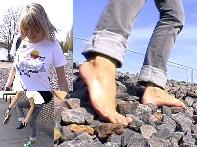
|
| |
|
Starting Out
|
Overall Health & Shoes
|
Barefoot Living

(Photos: http://forum.city-feet.com/index.php/showtopic.484 )
ON THIS PAGE
Starting Out
Overall Health & Shoes
Starting Out
Here are some tips for anyone who wants to start walking barefoot:
Step down, do not shuffle your feet when walking. This will prevent any sharp objects from cutting your soles. The soles are very elastic; therefore, small objects will stay in the surface of your skin and will not puncture it if you step down on them, as opposed to dragging them by shuffling your feet.
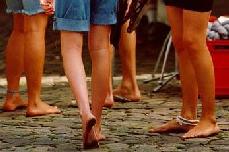
|
| |
Start with areas that have less challenging surfaces, such as even pavement, grass, etc. Ideal places for barefoot beginners are parks, bike and walking paths, open streets. Then, you can progressively increase the roughness of the walking surfaces.
Start barefooting in the mornings or early evenings, when the sun is not shining so hot on the pavement.
Moisturize your feet with lotion to keep the skin's natural flexibility. Lotions containing lanolin, urea, and glycerin are especially good. Other effective moisturizers are olive and vegetable oils. It's best to apply moisturizers at bedtime to allow the skin to absorb them more effectively. If you use oils, you might consider wearing a light pair of socks to bed, as to avoid staining your sheets.
Carry a pair of light sandals or slippers with you as a "backup", in case you feel the need to put something on. However, try to resist the temptation of putting them on too soon, otherwise, you'll get back to square one, and will not allow your feet to get used to staying bare.
Look ahead about ten paces ahead of you when you walk. This will help you recognize possible obstacles or hazards in your path, so you can avoid them accordingly.
Have fun! Going barefoot is something you should enjoy and feel good about. Use safe procedures, but give yourself the freedom of doing something exciting and different, keeping in mind that it will also bring you benefits and joy.
What is the NATURAL design of the foot as it responded to hard edges before the advent of modern footwear; |
http://heelspurs.com/_intro2.html
If someone has a lack of flexibility in their soles, walking barefoot can be painful on hard surfaces. Not just because they are hard, but because cushioned surfaces "give" and "place a spring in your step" that creates a lack of flexibility in the calf muscles. Turning the front of the foot inward toward the other foot while walking and walking on the outside edges of the feet lessens the strain on the sole.
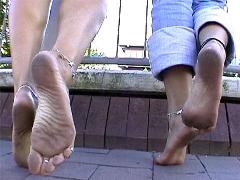
|
| |
The moment of maximum tension is when the heel begins to come off the ground and is called "heel off" in the gait cycle. The combination of hard surfaces and lack of flexibility in the calf muscles appears to greatly increase tension in the fascia.
During the 19th century most American boys went barefoot during the summer. There were several reasons for this. First and foremost, shoes and boots were expensive in the 19th Century. Parents probably didn't want their children wearing them out too rapidly. Many probably could not afford new shoes. Thus it was quite common for less affluent to let children go barefoot.
Manly:
American boys thought it was "tough" or "manly" for a boy to go barefoot as much as possible.
According to the autobiography of Samuel Clemens (Mark Twain):
... a boy who didn't go barefooted, or wore shoes when it was not absolutely necessary, was viewed as a "Miss Nelly". The unfortunate lad being an object of complete derision among my companions.
Thus going barefoot for rural and working-class boys and girls was not necessarily associated with poverty in 19th century America. This varied substantially from Europe where the lack of shoes was considered a sign of poverty.
Attitudes toward going barefoot vary greatly from country to country. In some countries it meant virile, healthy boyhood and freedom from uncomfortable shoes. Outlooks varied greatly among countries. One of the factors of course is climate.
 There is ample evidence that 19th century American youngsters would go barefooted out of "choice" rather than "necessity". In a D. B. Taylor sketch, "Unfledged Johnnys" from "Through the Valley with Sheridan-1864", made in late summer, 1864, in the northern Shanandoah Valley of Virginia, we can see that two of the three boys are barefooted. Yet all three are dressed in good quality clothing, lacking any sign of dilapidation. One boy is, in fact, wearing an "adult" coordinated sack suit of horizontally striped cloth (probably wool/cotton "jeans" cloth). The other boys are wearing either short "roundabout" jackets, or sack coats. There is no evidence of any raggedness or poverty.
There is ample evidence that 19th century American youngsters would go barefooted out of "choice" rather than "necessity". In a D. B. Taylor sketch, "Unfledged Johnnys" from "Through the Valley with Sheridan-1864", made in late summer, 1864, in the northern Shanandoah Valley of Virginia, we can see that two of the three boys are barefooted. Yet all three are dressed in good quality clothing, lacking any sign of dilapidation. One boy is, in fact, wearing an "adult" coordinated sack suit of horizontally striped cloth (probably wool/cotton "jeans" cloth). The other boys are wearing either short "roundabout" jackets, or sack coats. There is no evidence of any raggedness or poverty.
A modern illustration of the world's two favorite barefoot boys, Tom Sawyer and Huckleberry Finn is remarkable in its accuracy. Here again, Tom Sawyer is dressed in a very stylish, short 1840's roundabout jacket, with a white, broad collared shirt, and well kept trousers with "mule ear" style pockets, to give the impression that he's a 12 year old "grown-up".
There are probably many reasons for the lack of shoes in American (and Australian/New Zealand) youngsters of this time period. First and foremost, shoes and boots were expensive, and parents probably disliked their children wearing them out too rapidly, so they may have encouraged the affectation. More likely however, an older boy's or young teenager's shoes were invariably uncomfortable in warm weather! The modern sneaker wouldn't arrive on the scene until nearly a century later, providing an alternative to the torture of leather shoes in the summer.
Even today, American and Australian youngsters, and even more so New Zealand boys, go barefoot in summer as a rule, especially at summer seaside and lakeshore resorts and camps. Often they do so at shopping malls or just "around the neighborhood". It still is viewed in the States as a sign of "toughness" and freedom. One wonders if this affectation doesn't somehow hark back to the Irish, Scots-Irish and Scottish roots of so many of the pioneers of these colonies of the British Isles?

|
It might sound messy to be walking in newly plowed soil. Actually, the stubbles in a newly cut wheat field were not exactly foot-friendly and we soon learned to walk straight ahead between the rows.
|
|
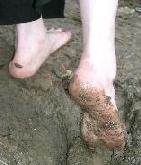
|
|
Mornings - even in the winter - we crawled from bed and ran as fast as possible through rain, snow, ice (and anything else that was out there), to the outhouse in the back yard. With our feet on the cold ground, and cold wooden slats against our backsides, we didn't linger in there for long! If any of us complained, we were always told that the cold was good for the feet. I believe it. We all had tough soles that could put up with anything nature could throw at us.
|
|
Going barefoot for half of the year was not only great fun, but it made us strong and it gave us a certain confidence that can only be known by roaming the earth "naturally." It also made us feel hundreds of things that get missed by those who are afraid (or forbidden) to leave their shoes at home. It was a small matter to us at the time, but I'd regret not having experienced it.
The artificial requirement of shoe-wearing for children of the modern era has correlated to an increase in health problems which may be related. At one time, most degenerate childhood conditions were considered unusual or abnormal by physicians or parents because they did not commonly exist in earlier generations. But those old-timers who saw these occurring as new plagues have long since passed on. Furthermore, the diseases have so increased in prevalence, affecting many more children and the resulting generations of adults, that most regard them as "normal" now in the United States. Although they may not be normal in Nature, conditions such as tonsillitis, earaches, vision disorders, acne, growing pains, potty-training problems, or frequent colds are all "normal" in modern society. Will childhood depression also become "normal" someday in society?

|
|
|
|
Photos: http://forum.city-feet.com/index.php/showtopic.484 |
It has been shown that barefoot walking improves psychological well-being. Theories include the electromagnetic force emanating from the earth's surface recharging the weary body and soul of the barefooter; and the undulations of the land having a stimulating effect on the foot's nerves and circulation; and that the foots nerves are connected to the nerve functions of other parts of the body. Whatever the reason, we were naturally designed to walk barefoot whenever safety permits. The circulation of the foot never reaches its full flow without movement of the sole's surface, and the foot's healthy growth: strength, arch-development, and good balance - depends upon walking barefoot in early youth.
There seems to be something in our environment causing widespread degenerative disease. Footwear has altered the environment under which Nature molded us, thereby contributing to the modern plague of degenerative diseases. Most people, including doctors, have never seen a natural foot, unaltered by footwear. Pointed toe fashions make the foot look slimmer, more 'aristocratic,' which has status appeal for most people. But the foot is not a slender stem, but a highly-engineered tool meant to take the brute force of our body's weight pounding against the earth. Shoes are designed to make them too weak and deformed to carry out their naturally-designed task.
We can look back thousands of years at ancient Greek art to see that the big toe pointed straight ahead towards the middle of the body instead of angled out to the side. The toes were spaced and spread out, not crowded together. However, examine any medical textbook from the last century and you will see a badly deformed foot, with crowded toes that come to a point with no spreading at all.
 |
When not trapped by shoes, the bones and muscles expand and strengthen to "grasp" the terrain and respond to the body's natural balance and movement. The shape may appear "odd" today because modern feet have been trained to conform to the shape of the footwear they've been imprisoned in. |
All shoes make natural walking impossible. They make a natural barefoot gait impossible. Design of the last (a mold upon which the shoe is built) causes concavity under the ball of the foot, and produces distress to the foot which is normally accustomed to a planar (flat) surface. The natural foot is a straight-axis design, so that a line drawn from the heel to the second and third toes will equally divide it.
Inflexible shoes substantially weaken the muscles of the toes and feet, single-handedly turning Nature's million-year effort into a pair of stumps. Perhaps most importantly, shoes cause the wearer to lose touch with reality?literally?by eliminating sensory contact with their environment.
We depend solely on our feet for supporting and moving the structure above them, and so the condition of the feet would seem to fundamentally determine the condition of the entire body. Despite their size, the feet contain over one-fourth of the bones and joints in the entire body.
A person who wears shoes during the formative years develops an unnatural gait and poor balance, resulting in postural changes throughout their entire body. In a fallen-arched gait, the feet turn outward and the weight comes off the inner arch instead of the ends of the toes, producing a labored, shuffling or waddling gait. In a heel-to-toe gait, the feet are pointed forward, and the weight comes off the toes at the end of each step, so the foot is being effectively used as a lever of propulsion.
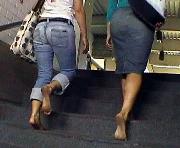
|
| |
Multiple sclerosis is one such disease that typically affects relatively young and healthy people, and there is no known cause. People in the U.S. and Europe have a higher chance of developing it than those in undeveloped countries, where children go unshod more often.
|
|
Consider the health effects of these unnatural conditions caused by shoes:
Eye disorders such as astigmatism and myopia are abnormal conditions in the shape of the eyeball and lens. The ancient Greeks saw the stars of the night sky just fine without eyeglasses, but even a large, bright moon appears as a blurry blob to many modern-day teenagers in need of coke-bottle lenses. There was little need or demand for corrective lenses until modern times. In 1828, the first plano-concave cylindrical lenses to correct myopic astigmatism were ground.
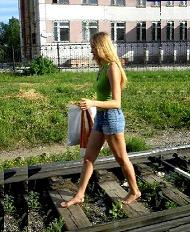 |
By 1870, using inexpensive mass-production methods, shoe manufacturing had suddenly become America's largest industry and largest employer with growing retail outlets and stores. The shoe has become the most common object with the least amount of suspicion in common disease and disorder.
The foot is able to manage a number of terrains: flat, hard, yielding, soft, curved, tilted, or other. Apparently, it is this very same ability that leads to painless foot deformation from wearing shoes: the foot is simply adapting to the warped shoe that is imposed upon it. However, as part of the foot deformation process, the body itself must change, leading to alteration of its internal functioning. Until somebody invents the ideal shoe (assuming that one even exists), going barefoot from birth is the only way to achieve a gait and an organic functioning that Nature intended.
More from
http://www.shoebusters.com/thesis.html
From: http://www.barefooters.org/scrapbook/jobs.html
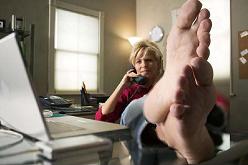 www.inmagine.com |
"...When I was seventeen, I broke my back in a fall from a horse. I have suffered from acute and chronic lower back and sciatic nerve pain ever since. I discovered that standing and walking barefooted was far less painful than doing the same while wearing s#^*s. This revelation started my now forty years of barefooting. To this day, the same holds true. If I put anything, even flip flops on my feet, the pain in my lower back and sciatic nerve starts increasing. If I continue wearing s#^*s for more than an hour or so, I become so crippled with pain that I cannot walk or stand. In bare feet, I function well enough to lead a fairly mobile life. In s#^*, I soon become a cripple unable to function at all.
from San Diego:
I had no real expectations about the health of my feet when I started barefooting on a regular
basis a little over 5 years ago. I did experience a number of health issues with my feet improve
and/or completely disappear. I have diabetes and my touch test with a mono-filament line about
the consistency of a broom straw improved from 85% to 100%. No longer do I have athletes foot or
foot odor. Four of my toes had gone numb over 30 years ago and the feeling has returned to them.
All benefits of going barefoot.
Our 3 year old suddenly began stuttering and stammering. I thought about if we changed anything in Jeremy's schedule or clothing when the stuttering began. I couldn't think of anything, I realized we had recently bought him his first pair of hard shoes. We stopped having him wear the shoes... and that was the end of his stuttering and stammering.
The civilized walk - or "cow-walk," puts tremendous pressure on the joints, and is learned from wearing shoes. Shoes inhibit the natural motion of the foot.
In contrast, "fox-walking" is natural - the body's in total synchronization. Knees are bent, not locked; the ball of the foot touches the ground first, then the heel, in a virtually soundless step motion. Fox-walking occurs intuitvely from walking barefoot.
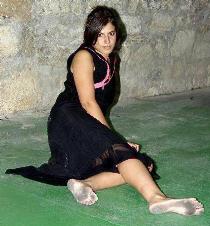
|
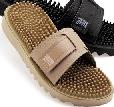 |
Customer reviews for this type of slide
Barefoot in Toronto
Multiple articles, beginners' tips
Society for Barefoot Living -
Articles, tips, and encouragement
Shoebusters.com - Connections between
shoes & disease . . .
Shoes & children's disorders
How shoes affect physical & mental health
Barefoot conditioning (Saxton)
Google - wide toe box shoes . . .
HOME